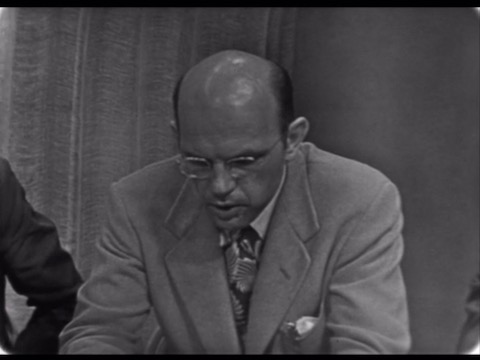Soap Box; The Slum; Part 2
- Series
- Soap Box
- Episode
- The Slum
- Segment
- Part 2
- Producing Organization
- KETC-TV (Television station : Saint Louis, Mo.)
- Contributing Organization
- The Walter J. Brown Media Archives & Peabody Awards Collection at the University of Georgia (Athens, Georgia)
- AAPB ID
- cpb-aacip-526-w950g3jc46
If you have more information about this item than what is given here, or if you have concerns about this record, we want to know! Contact us, indicating the AAPB ID (cpb-aacip-526-w950g3jc46).
- Description
- Episode Description
- This is "The Slum" as described above. This special episode "presented a group of women who lived in [a Saint Louis] slum, telling about life in the slum. The portion of the program was done without any moderator and without any script [although edited]. The second portion of the kinescope is the discussion which followed in which people with varying points of view use the raw material of the women's discussion to formulate their own ideas about the slum problem in Saint Louis."--Excerpted from accompanying paper materials. The second panel comprises local experts in issues of housing and poverty. They are: Mr. Gene Bradley of the St Louis Housing Authority and the manager of the new housing project; Clement Mihanovich of the Department of Sociology of St. Louis University; Charles Copley of the St. Louis Health Department; Mr. Carl Siegenthaler of the Caroline Mission; Mr. Leo Bohanon of the Urban League; and Mr. Sam Michaelson of the St. Louis Real Estate Board.
- Series Description
- "The SOAP BOX takes up local public issues in a rather striking and unusual manner. It considers slums, highways, juvenile delinquency and other series issues from the point of view of those who are on the inside -- those who really live the problems. The point of this program is to present problems with the greatest possible emotional impact and sense of reality and to get the citizen to participate with the expert in analyzing possible community actions. "One of the programs submitted -- 'The Slum' -- is typical of the series in that it presented a group of women who lived in the slum telling about life in the slum. The portion of the program was done without any moderator and without any script. The people were carefully chosen and prepared psychologically for the broadcast. What we see on the screen is as close as anyone can get to the real thoughts of people in this predicament. The second portion of the kinescope is the discussion which followed in which people with varying points of view use the raw material of the women's discussion to formulate their own ideas about the slum problem in Saint Louis. "A second program submitted on the integration of white and Negro students in the Saint Louis public schools is representative of a special SOAP BOX service. From time to time this program has taken unusual issues and presented them to a specific, rather than general audience. In the case of the integration series, SOAP BOX cooperated with the National Conference of Christians and Jews and the Saint Louis Public School System to produce three program[s] which were viewed by all Saint Louis elementary teachers in their regular teachers meetings, as a way to help prepare them for the coming integration of white and Negro students. Anyone could watch these programs, but they were directed to doing a specific job for the Saint Louis Board of Education. "The third program submitted -- 'Security Hearings' -- was another special SOAP BOX feature 'one of the few times SOAP BOX went into the area of national affairs. In this case, we took the problem of freedom and security as it was demonstrated in a local security case. "A number of techniques were employed by SOAP BOX in presenting issues. Sometimes we were able to get the inside story by hearing the people who had the problems directly. Sometimes it was necessary to use role playing to get the inside story [,]as in the case of the integration program; and sometimes, as in the case of 'The Security Hearing,' actual documentary resources were used to present the raw material of the issue. "The enclosed folder of newspaper clippings and editorials will give you some idea of the impact of this program on the Saint Louis community."--1950 Peabody Awards entry form.
- Created Date
- 1955
- Asset type
- Episode
- Media type
- Moving Image
- Duration
- 00:33:48.860
- Credits
-
-
Associate Producer: Schneider, Martin
Co-Producer: Lincoln, Ranlet
Moderator: Lincoln, Ranlet
Producer: Simon, Mayo
Producing Organization: KETC-TV (Television station : Saint Louis, Mo.)
- AAPB Contributor Holdings
-
The Walter J. Brown Media Archives & Peabody Awards Collection at the
University of Georgia
Identifier: cpb-aacip-b3dcbbecb3f (Filename)
Format: Audio cassette
Duration: 1:00:00
If you have a copy of this asset and would like us to add it to our catalog, please contact us.
- Citations
- Chicago: “Soap Box; The Slum; Part 2,” 1955, The Walter J. Brown Media Archives & Peabody Awards Collection at the University of Georgia, American Archive of Public Broadcasting (GBH and the Library of Congress), Boston, MA and Washington, DC, accessed January 8, 2026, http://americanarchive.org/catalog/cpb-aacip-526-w950g3jc46.
- MLA: “Soap Box; The Slum; Part 2.” 1955. The Walter J. Brown Media Archives & Peabody Awards Collection at the University of Georgia, American Archive of Public Broadcasting (GBH and the Library of Congress), Boston, MA and Washington, DC. Web. January 8, 2026. <http://americanarchive.org/catalog/cpb-aacip-526-w950g3jc46>.
- APA: Soap Box; The Slum; Part 2. Boston, MA: The Walter J. Brown Media Archives & Peabody Awards Collection at the University of Georgia, American Archive of Public Broadcasting (GBH and the Library of Congress), Boston, MA and Washington, DC. Retrieved from http://americanarchive.org/catalog/cpb-aacip-526-w950g3jc46
